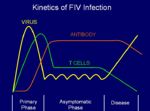Difference between revisions of "Feline Leukaemia Virus"
Jump to navigation
Jump to search
| Line 18: | Line 18: | ||
==Clinical Signs== | ==Clinical Signs== | ||
| − | *'''Leukemia''' | + | *'''Leukemia''' - a neoplastic increase in blood cell numbers - usually white blood cells |
*'''Multicentric lymphosarcoma''': B or T cell tumors, which may be palpable as enlarged lymph nodes (particularly mesenteric) | *'''Multicentric lymphosarcoma''': B or T cell tumors, which may be palpable as enlarged lymph nodes (particularly mesenteric) | ||
*'''Thymic lymphosarcoma''': T cell tumors, with only the thymus enlarged | *'''Thymic lymphosarcoma''': T cell tumors, with only the thymus enlarged | ||
Revision as of 15:14, 30 October 2010
Also known as FeLV
Introduction
Pathogenesis
- FeLV is the "disease of friends": transmission usually occurs through mutual grooming
- From the oropharynx, virus spreads to most tissues in the body to replicate, notably:
- Bone marrow
- Thymus
- Salivary glands
- Reproductive tract
- Most kittens but only 30% of adults become viremic for life without producing antibody
- 20% of viremic cats die of tumors
- 30% of viremic cats die of FeLV-associated disease
- 80% die within three years of exposure
- 30% of adults exposed become latently infected and can become viremic when immunosuppressed
- 40% of exposed adults remain healthy and develop Ab and CD8+ Tcells after clearing the virus, without becoming reinfected or silent carriers
Clinical Signs
- Leukemia - a neoplastic increase in blood cell numbers - usually white blood cells
- Multicentric lymphosarcoma: B or T cell tumors, which may be palpable as enlarged lymph nodes (particularly mesenteric)
- Thymic lymphosarcoma: T cell tumors, with only the thymus enlarged
- Results in dyspnoea
- Confirmed by radiography
- Alimentary lymphosarcoma: B cell tumors of the Peyer's patches
FeLV-associated disease:
- Immunodepression causing secondary disease
- Reproductive failure: FeLV crosses the placenta, causing fetal resorption or viremic kittens with thymic aplasia
Epidemiology
- Vertical transmission of FeLV-A from mother to kittens either via placenta, grooming, or milk
- Horizontal transmission occurs via saliva during mutual grooming
- Recovery linked to age and presence of maternal antibody
- Particular concern for intensively bred cats because of crowding, etc.
Antigenicity
- Main envelope protein: gp70
- 3 antigenic subgroups:
- Group A
- is transmitted between cats
- is monotypic: one vaccine covers all isolates
- causes lymphosarcoma
- Group B:
- is recombinant with transmissible FeLV-A
- increases the chance of thymic tumors
- Group C:
- is a mutant of A
- isolates are rare, and occur as A+C mixtures
- increases chances of anemia
Diagnosis
- FeLV should be suspect in any cat with recurrent bacterial infections, anemia or weight loss
- ELISA for Antigen (capsid protein p27 or envelope protein gp70)
- Immunochromatography is now trusted as ELISA testing can give false positives
- Virus isolation from heparinised blood can now be performed to confirm a positive diagnosis
ELISA
- Rapid-Immuno-Migration
- Western Blot
- Virus Isolation
- Immunofluorescence
- PCR
Infection Control
- Antigen positive sick cats should be destroyed
- Healthy positive cats should have diagnosis confirmed
- Vaccination:
- Should take place once antigen-negative status has been determined
- Leukogen: Subunit vaccine (using envelope protein gp70) produced in E. coli mixed with Quill-A and alhydrogel
- Others include inactivated virus and canarypox recombinants, but all MUST include FeLV-A
(FeLV)

FeLV Electron Micrograph Public Health Image Library Image #5610
- Oncogenic retrovirus
- Causes neoplasia (lymphoma), myelosuppression (anaemia) and immunosuppression (of T cells)
- 2 strains:
- FeLV-A
- Natural strain
- FeLV-B
- Formed through FeLV-A recombining with endogenous retroviral sequences in the feline genome
- Increases the risks of lymphoma
- FeLV-C
- Formed from the spontaneous mutation of FeLV-A
- Is more myelosuppressive
- FeLV-A
- Virus replicates in the oropharyngeal lymphoid tissue causing a viraemia (virus circulating in the bloodstream) which then spreads to the systemic lymphoid tissue
- Shed in saliva
- Passed by oronasal route, e.g. mutual grooming
- Kittens between 6 weeks and 6 months are most susceptible
- 60% of cats will become immune to the disease and recover
- Cats that are persistently viraemic will progress to develop FeLV-associated diseases
- Some cats will become viraemic again if treated with corticosteroids or stressed if the infection lies dormant in the bone marrow
Treatment
- Antibiotics for secondary infection
- Anti-retroviral therapy
- For vaccinations see here
